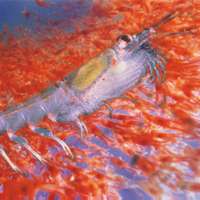
CRYOPHILIC PROTEASES: Wash better and whiter |
|
Most detergents contain enzymes in their formulations. The most used are known as proteases, and have maximum activity at temperatures around 50 or 60°C. But this situation could change thanks to a Chilean project which is studying an enzyme able to obtain similar results at lower temperatures. What does antartic krill have to do with all this? Here we tell you. |
|
 |
The protease used by investigators of the Centre was extracted from krill. Nevertheless, krill is not suitable as a raw material : from 2.4 kilos of krill only about 4.7 milligrams of protein are obtained. For some time the idea of “biological” or “intelligent” detergents has been familiar. This is because their formulas, among other things, contain a particular type of enzyme called proteases, that act by dissolving proteins, which allows them to effectively attack spots of organic origin (blood, grass, sweat). The one currently used is called subtilisin, and the optimal temperature for its action is near 60°C. Obviously, this implies the use of hot water for laundry. |
|
|
The idea of finding and commercialising enzymes that work at lower temperatures interested a group of investigators at the Centre of Biochemical Engineering and Biotechnology of the University of Chile, located in the Faculty of Physical and Mathematical Sciences. Through a Fondef project carried out together with the company Bios-Chile, they initiated the investigation. Juan Asenjo, engineer and director of the Centre, narrated the sequence of events that took them to track the routes of the boats going and coming from Antartica “We needed to find enzymes that worked at low temperature. We thought about antartic organisms. The subtilisin comes from a bacterium, bacillus subtilis, and we hoped that in Antartica there were relatives of this bacillus”. |
|
Juan Asenjo, director of the Centre for Biochemical Engineering and Biotechnology, in one of the laboratories where the protease is extracted from krill.... |
 |
- And it was not just buying krill at the supermarket In fact, the first time that the project was approved, we were told that we were not going to be able to obtain the material. The main traders of krill are Japanese, but it is fished by Polish boats. Then, to obtain it, it was necessary to call Japan and find out what boats were in the zone at that time. We need the DNA of krill, and it had to be frozen, to avoid autolisis. We nearly had to travel to the Falklands, one of the points of the route of the boats, but in the end we obtained it in another way. Later, a problem was that neither in the Falklands nor in Punta Arenas was there any dry ice needed to conserve krill. We had to send it from Puerto Mont. After that adventure, Asenjo and his group at the Centre were faced with the task of extracting the enzyme. First krill is compressed to remove all its liquid (“what interested us was in the digestive part”), afterwards, there are purification processes using chromatography and electrophoresis. The last is a technique consisting of applying an electric field to the matter, causing the separation between proteins on the basis of its characteristics either of charge or molecular weight. Later zimograms are made, which Asenjo describes as “the fingerprint of the protein activity” - What have been the results? We have isolated several enzymes with protease activity, but there is a trypsin like enzyme that is the champion. It has better activity at low temperature than subtilisin. We have already sequenced part of the protein, the sequence was entered in to an international data-base. This protein will be patented and then we would be properly speaking of a commercial product. The next step, he explains, is to isolate the DNA of the protein to clone and produce it in a industrial form: “ The krill is being used as a model because it lives at low temperatures. But imagine if we counted on it as the only source of raw material. From 2.5 kg of krill you obtain 4,7 milligrams of the protein” The team involved in the research hopes by September of this year to have the gene of the enzyme expressed in Escherichia coli. Once cloned, the gene becomes a solid commercial product in a field where practically there are no competitors “ the idea is to have another project after this, to sharpen details of this protein and others, like lipase, an enzyme that degrades fats” The subject has been so promising at industrial level, that Novo-Nordisk the main enzyme producer in Europe, has been interested in the project from its beginning “ With them we have had a joint project to develop glucanase enzymes that make permeable the wall of yeast and liberate products formed inside them such as recombinant vaccines. They also have helped to define the world-wide potential market of this enzyme”. Amongst the characteristics of the project, Asenjo emphasises the beneficial collaboration between the scientists of the Centre and those of Bios-Chile. - The gene has been baptized? No. We speak of cryophilic proteases, because they have activity at low temperatures. Now, it is interesting to remember that in the project there is a very important basic component related to the functions of the Centre, that is all the protein engineering, to understand why enzymes exist that have activity at low temperature, how they developed. That is something that has to do with the evolution of the species. |
|